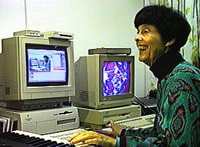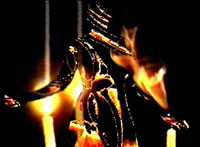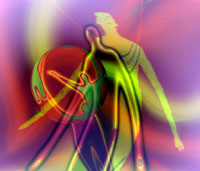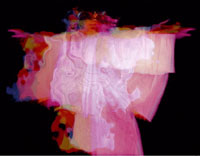Sylvia Pengilly (I take the fifth amendment – present)
 Childhood, Early Music Education Childhood, Early Music Education
Born in London, England a few years prior to the onset of WWII, some of Sylvia Pengilly’s earliest memories are of a lullaby of gunfire, and the whine, followed by the terrifying silence, of V-2 rockets, as they homed in on their targets of destruction. When the bombing became too bad, the family, minus her father, who had been “called up” into the army, was evacuated to rural Sussex. It was here that she was first introduced to the wealth of English folk music as part of the weekly music class, which was accompanied by the music teacher playing the rickety school piano.
After the war the family, happily including her father, returned to London, where Sylvia begged for piano lessons. These were provided by her parents, with the stern injunction that they would stop if she ever had to be told to practice. This never happened, in fact, the opposite was the case, and she usually had to be forcibly dragged away from the piano for meals, sleep, etc.
Her high school provided an excellent education, and the music teacher there encouraged her students to write short compositions to complement their theory and piano studies. And so it was, after hearing her first Bach fugue, that the excited teenager went home and produced her first composition, a fugue modeled on Bach’s C minor fugue from Book I of the Well Tempered Clavier. Who could ever hope to have a better teacher than J.S. Bach?
When it came time for college, music was the only discipline she would consider. Normally very submissive to her parents’ wishes, she was adamant that this was the only career she wanted to pursue. Her parents finally agreed, with the proviso that her course of studies be in music education so that she would be equipped to make a living. It was a very frightened and apprehensive student who arrived at the steps of the Guildhall School of Music and Drama one rainy day in the mid-1950s, but it was also the beginning of a very exciting journey that continues to this day.
Graduate Studies
 In 1956 she married research chemist Brian Pengilly, who was subsequently offered a job at Goodyear Research, and the couple moved to Stow, Ohio, in 1957. Using her music education degree, Sylvia taught elementary school music for several years before deciding to pursue a degree in composition at Kent State University in 1968. This was a major step, since her musical education was very different from the Kent State curriculum; however, once a few differences in terminology had been straightened out, she began to thoroughly enjoy her studies, which included composition with John White and later with James Waters. It was there that she was introduced to electronic music, the (then) chairman having purchased a state-of-the-art Moog 55. From that time on, she spent every spare moment with the Moog, learning in a very tangible way how to change the sound of a simple waveform by using filters, envelopes, ring modulation, etc. In 1956 she married research chemist Brian Pengilly, who was subsequently offered a job at Goodyear Research, and the couple moved to Stow, Ohio, in 1957. Using her music education degree, Sylvia taught elementary school music for several years before deciding to pursue a degree in composition at Kent State University in 1968. This was a major step, since her musical education was very different from the Kent State curriculum; however, once a few differences in terminology had been straightened out, she began to thoroughly enjoy her studies, which included composition with John White and later with James Waters. It was there that she was introduced to electronic music, the (then) chairman having purchased a state-of-the-art Moog 55. From that time on, she spent every spare moment with the Moog, learning in a very tangible way how to change the sound of a simple waveform by using filters, envelopes, ring modulation, etc.
In 1971, having graduated with an master of arts in composition, she joined the faculty of Kent State as an instructor of theory. The same year her marriage ended in divorce, which prompted her to move to the University of Cincinnati where she began a doctoral degree in 1973. This was, again, a completely new environment, but one she entered with great enthusiasm, particularly since the College/Conservatory of Music was the proud possessor of an electronic music studio including an Arp 2600, an ElectroComp, and a fearsome looking patching matrix. Here she studied acoustic and electronic composition with Paul Palumbo.
Having finished her course work, she was offered a position at Western Illinois University, Macomb, Il., where she taught theory and composition for four years. It was there, through an association with Dr. Richard Peterson of the physics department, that she discovered that Lissajous figures (visual patterns that represent the ratio between the two frequencies of an interval) could be generated using a laser/mirror system built by Dr. Peterson. She used this system in several compositions, including “Incantation,” for percussion and electronics, and in her dissertation, “The Pi Man,” for chamber orchestra, dancers, electronic tape, and laser patterns.
Loyola “Crazy Person,” New Technology
In 1980 she was offered a position at Loyola University, New Orleans, where she taught for the next fifteen years. At that time, the theory/composition area was chaired by Dr. Patrick McCarty, a very traditional theorist and composer, who, in spite of his own preferences, had the imagination to realize that the students also needed exposure to more avant garde approaches, including electronic music. Sylvia was therefore hired to be the “crazy person” of the theory/composition area, which gave her a wonderful freedom to explore and experiment with the full support and cooperation of her colleagues. where she taught for the next fifteen years. At that time, the theory/composition area was chaired by Dr. Patrick McCarty, a very traditional theorist and composer, who, in spite of his own preferences, had the imagination to realize that the students also needed exposure to more avant garde approaches, including electronic music. Sylvia was therefore hired to be the “crazy person” of the theory/composition area, which gave her a wonderful freedom to explore and experiment with the full support and cooperation of her colleagues.
At that time Loyola was the proud possessor of a Moog 55, which was familiar to her from Kent State, a pair of speakers, and a mixing board. She built up the studio over the years, at first adding a four-track Tascam tape deck and a Zenith computer to control the Moog, enabling the students to create musique concrete and mix their recorded sounds with sounds generated on the Moog. In 1984, when desktop computers became available, Mac computers were added, running the MOTU “Composer/Performer” software, and a DX7 keyboard. Later, a Kurzweil keyboard and several rack-mounted synthesizer modules were added, along with “Finale,” “Pro-Tools,” and other compositional software, creating a modest, but eminently workable composition studio.
During this time, in addition to working with the Mac hardware and software mentioned above, Sylvia was also working on integrating graphics with music using an Amiga computer (alas, now defunct) running the “Mandala” software, which allows the performer/composer to create a virtual world, then to have her image enter that world, where it is able to trigger “events” in realtime by virtually touching previously created icons. In order to realize pieces created in this way, a very detailed knowledge of the software is required, so it soon became apparent that she, herself, would have to be the performer. So, armed with ballet lessons from the Loyola dance instructor, Gayle Parmelee, white tights and leotard, she began creating works that integrated not only music and graphics, but also dance. These works include “The Wizard of Id,” “Shadows,” “Alternate Spaces,” and “DarkPlaces.”
 Constantly looking for new technology to aid in the realization of her visions, in 1995 she began exploring the possibilities of using brain waves as a direct aid to composition. For this she used the Interactive Brainwave Visual Analyzer (IBVA), which consists of a headband with electrodes, that reads brain activity, then converts it to electrical data. This is then transmitted, over radio frequencies, to a receiver that is attached to a computer, where it is converted to MIDI information. Using a MAX patch, this MIDI information is used to control the unfolding of the piece. “Interface: Music From the Mind” and later “Haunted Resonance” are examples of pieces created using this technology. These pieces integrate music with graphics, both of which are triggered by the performer’s brain activity at the time, resulting in a unique performance each time the piece is presented. Constantly looking for new technology to aid in the realization of her visions, in 1995 she began exploring the possibilities of using brain waves as a direct aid to composition. For this she used the Interactive Brainwave Visual Analyzer (IBVA), which consists of a headband with electrodes, that reads brain activity, then converts it to electrical data. This is then transmitted, over radio frequencies, to a receiver that is attached to a computer, where it is converted to MIDI information. Using a MAX patch, this MIDI information is used to control the unfolding of the piece. “Interface: Music From the Mind” and later “Haunted Resonance” are examples of pieces created using this technology. These pieces integrate music with graphics, both of which are triggered by the performer’s brain activity at the time, resulting in a unique performance each time the piece is presented.
California, Continuing To Explore
In 1995 she “retired” and moved to California, where she still resides. Over the past eleven years she has given many performances and lectures, notably at The University of California at Irvine, Stanford University, California Institute of the Arts, and the University of California at Santa Barbara.
She continues to compose and explore, and, in an attempt to stay current, she frequently attends conferences on electronic music, notably the annual conference of the Society for ElectroAoustic Music in the United States (SEAMUS). It was at one of these conferences, held at Arizona State University in 2003, that she met fellow-composer Michael Rhoades. While walking to the conference site, they began discussing quantum computers, sub-atomic particles that spin both ways at the same time, and a host of other subjects of great interest to both of them. The friendship still continues, and each has made a major contribution to the other’s work. Together they have so far produced two collaborative video/music works, “The Outer Edge of Possibility” and “Unperceived Dimensions,” for which Sylvia created the video and Michael composed the music. she frequently attends conferences on electronic music, notably the annual conference of the Society for ElectroAoustic Music in the United States (SEAMUS). It was at one of these conferences, held at Arizona State University in 2003, that she met fellow-composer Michael Rhoades. While walking to the conference site, they began discussing quantum computers, sub-atomic particles that spin both ways at the same time, and a host of other subjects of great interest to both of them. The friendship still continues, and each has made a major contribution to the other’s work. Together they have so far produced two collaborative video/music works, “The Outer Edge of Possibility” and “Unperceived Dimensions,” for which Sylvia created the video and Michael composed the music.
Who knows what the future will bring? It will undoubtedly involve creation, whether of music, video, or some as yet undiscovered art-form, since creation is life’s greatest joy.
--Sylvia Pengilly |